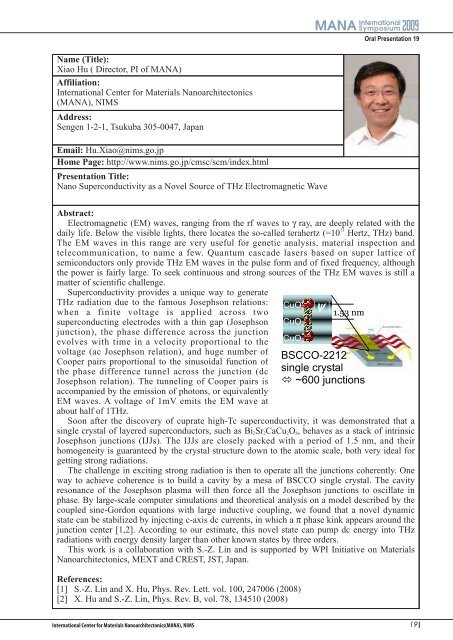Abstract Download (8.38MB)
Abstract Download (8.38MB)
Abstract Download (8.38MB)
Create successful ePaper yourself
Turn your PDF publications into a flip-book with our unique Google optimized e-Paper software.
Name (Title):<br />
Xiao Hu ( Director, PI of MANA)<br />
Affiliation:<br />
International Center for Materials Nanoarchitectonics<br />
(MANA), NIMS<br />
Address:<br />
Sengen 1-2-1, Tsukuba 305-0047, Japan<br />
Email: Hu.Xiao@nims.go.jp<br />
Home Page: http://www.nims.go.jp/cmsc/scm/index.html<br />
Presentation Title:<br />
Nano Superconductivity as a Novel Source of THz Electromagnetic Wave<br />
<strong>Abstract</strong>:<br />
Electromagnetic (EM) waves, ranging from the rf waves to γ ray, are deeply related with the<br />
daily life. Below the visible lights, there locates the so-called terahertz (=10 12 Hertz, THz) band.<br />
The EM waves in this range are very useful for genetic analysis, material inspection and<br />
telecommunication, to name a few. Quantum cascade lasers based on super lattice of<br />
semiconductors only provide THz EM waves in the pulse form and of fixed frequency, although<br />
the power is fairly large. To seek continuous and strong sources of the THz EM waves is still a<br />
matter of scientific challenge.<br />
Superconductivity provides a unique way to generate<br />
THz radiation due to the famous Josephson relations:<br />
when a finite voltage is applied across two<br />
superconducting electrodes with a thin gap (Josephson<br />
junction), the phase difference across the junction<br />
evolves with time in a velocity proportional to the<br />
voltage (ac Josephson relation), and huge number of<br />
Cooper pairs proportional to the sinusoidal function of<br />
the phase difference tunnel across the junction (dc<br />
Josephson relation). The tunneling of Cooper pairs is<br />
accompanied by the emission of photons, or equivalently<br />
EM waves. A voltage of 1mV emits the EM wave at<br />
about half of 1THz.<br />
Soon after the discovery of cuprate high-Tc superconductivity, it was demonstrated that a<br />
single crystal of layered superconductors, such as Bi2Sr2CaCu2O8, behaves as a stack of intrinsic<br />
Josephson junctions (IJJs). The IJJs are closely packed with a period of 1.5 nm, and their<br />
homogeneity is guaranteed by the crystal structure down to the atomic scale, both very ideal for<br />
getting strong radiations.<br />
The challenge in exciting strong radiation is then to operate all the junctions coherently. One<br />
way to achieve coherence is to build a cavity by a mesa of BSCCO single crystal. The cavity<br />
resonance of the Josephson plasma will then force all the Josephson junctions to oscillate in<br />
phase. By large-scale computer simulations and theoretical analysis on a model described by the<br />
coupled sine-Gordon equations with large inductive coupling, we found that a novel dynamic<br />
state can be stabilized by injecting c-axis dc currents, in which a π phase kink appears around the<br />
junction center [1,2]. According to our estimate, this novel state can pump dc energy into THz<br />
radiations with energy density larger than other known states by three orders.<br />
This work is a collaboration with S.-Z. Lin and is supported by WPI Initiative on Materials<br />
Nanoarchitectonics, MEXT and CREST, JST, Japan.<br />
References:<br />
[1] S.-Z. Lin and X. Hu, Phys. Rev. Lett. vol. 100, 247006 (2008)<br />
[2] X. Hu and S.-Z. Lin, Phys. Rev. B, vol. 78, 134510 (2008)<br />
CuO2 ����<br />
1.53 nm<br />
CuO2<br />
CuO2<br />
BSCCO-2212<br />
single crystal<br />
� ~600 junctions<br />
Oral Presentation 19<br />
19















